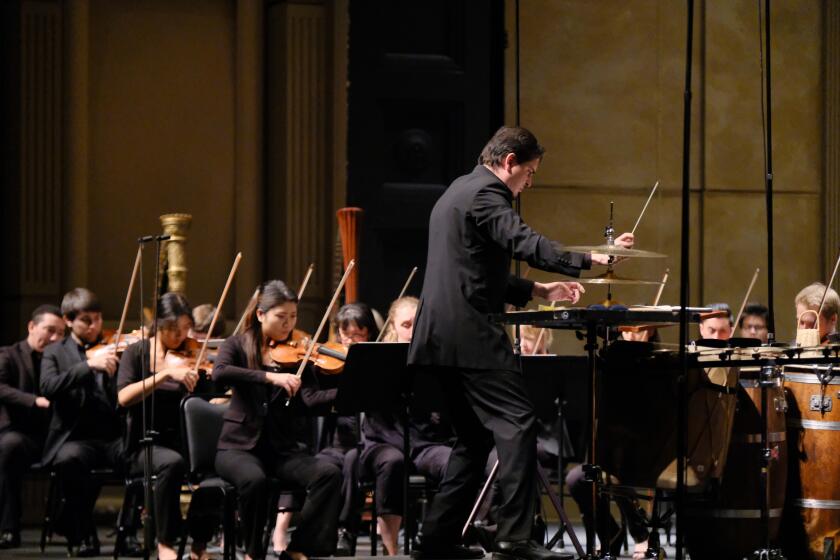Tuning Into Music’s Mathematical Nature
Blame it on Pythagoras. That music’s greatest “riddle” should be about intonation seems, on the face of it, rather silly. After all, our ears should tell us when two notes are in tune with one another, shouldn’t they?
The answer, as Stuart Isacoff makes clear in this charming book, is no, not by a long shot. But the reason musicians have long disagreed about tuning is not that their ears have changed so much in the last 21/2 millenniums. Rather, it’s that their philosophies have. How great minds--many of them musical, some of them apparently not--were able to disagree over the nature and meaning of consonance, and how those disagreements produced problems with the tuning of our musical scale, is the subject of Isacoff’s book. And because, once upon a time, music was a subject deemed worthy of scientific, philosophical and moral inquiry, Isacoff’s treatment turns out to be as much a whirlwind tour of Western culture’s big ideas as it is a musicological investigation.
To the ancient mind, music was a readily perceivable representation of cosmic order, its measured perfection and pure cadences at once a reflection of “the harmony of the spheres” and a means by which man could be in touch with the divine. The ancients’ assumption that music provided a connection between the earthly and the celestial was embraced by influential Christian writers such as St. Augustine (354-430) and eventually became a fundamental tenet of medieval music theory. A crucial role in this process was played by the early Christian philosopher Boethius (470-525), whose “De Musica” reconciled neo-Platonic and Aristotelian cosmology with Christian belief, and introduced the Pythagorean concept of musical ratios. Ah, Pythagoras!
Anyone who has studied geometry knows it was Pythagoras (circa 582 to circa 500 BC) who showed that the sum of the squares of the sides of a right triangle is equal to the square of the hypotenuse. This same Pythagoras, observing the effects of vibrating strings, noticed that beautiful, agreeable sounds were produced when the lengths of the strings were in certain ratios to one another, such as 3:2 (for the fifth, which refers to the distance, say, between middle C on the piano and the G above) and 4:3 (for the fourth, say, from C to F). The Pythagorean concept that consonance depended on simple ratios became the foundation for the medieval Christian notion of a universe ordered according to mathematical principles and reflecting the divine presence, and of music as a potent physical manifestation of that order--in essence, music as numbers made audible.
The problem was that this theory, on which early systems of tuning were based, didn’t quite work in practice. Stacking perfectly tuned fifths or fourths on top of one another did not produce a satisfactory-sounding octave. Singers could get around the difficulty, but it was impossible for instruments with a fixed tuning, especially keyboard instruments, to do so. Some kind of stretching or shrinking of the intervals between notes had to occur, and that practice came to be called “temperament.” Isacoff discusses the various temperaments that were tried, particularly “just” intonation (which tries to keep some of the Pythagorean ratios) and “mean-tone” temperament (in which the fifths are shortened, sacrificing a little more of the ideal), characterizing their strengths and weaknesses with great skill.
The author’s description of how these things sound, though insightful and easily grasped by the layman, necessarily falls short of the reality. You simply can’t imagine how good--and bad--a harpsichord in mean-tone temperament can sound until you’ve heard it demonstrated. At the Smithsonian, we used to do this by playing “God Save the King” in G major (marvelously bright and sonorous), and then a half step lower in F sharp major (where it sounded as though every note were wrong).
All of this sets the table, of course, for the “equal temperament” tuning in use today, a compromise system that appeared early in the 1700s and in which only the octave is pure, but every half step between notes is exactly the same distance from its neighbor. Isacoff shows us how musicians and philosophers wrestled with the theoretical and theological implications of this idea for centuries, before the weight of pragmatism finally won out over dogma.
The heroes of this story are the composers Adrian Willaert and Vincenzo Galilei (father of the astronomer), the scientist Daniel Bernoulli and the composer-theorist Jean Philippe Rameau. The villains--well, let’s not call them that--those who lined up on what proved to be the wrong side of the issue, a more numerous lot, include the theorist Gioseffo Zarlino (on the wrong side of many issues), the astronomer Johannes Kepler, philosopher-mathematician Rene Descartes, even Sir Isaac Newton.
Isacoff looks at the question of temperament primarily from the standpoint of the keyboard, not surprising considering his expertise in the piano and its literature. But the real payoff for equal temperament was modulatory freedom, in instrumental music of all kinds. It was not just being able to compose a piece of music in any one of the 24 major and minor keys, and have it sound good--as Bach did in “The Well-Tempered Clavier”--but being able to modulate freely within a given piece to any key: to depart from a “home” key or tonal center, to take an excursion, and to return. This led to a grand expansion of musical form and to the psychological and emotional impact of the music of Mozart, Beethoven, Schubert, Wagner and so many others. Isacoff could have said much more about this than he does, but perhaps that will be the subject of his next book.
*
Ted Libbey is the author of “The NPR Guide to Building a Classical CD Collection.”
More to Read
The biggest entertainment stories
Get our big stories about Hollywood, film, television, music, arts, culture and more right in your inbox as soon as they publish.
You may occasionally receive promotional content from the Los Angeles Times.






